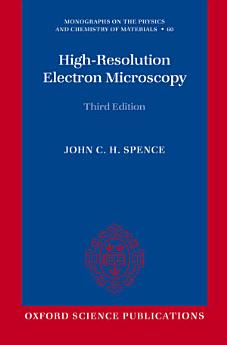High-Resolution Electron Microscopy: Edition 3
2008. g. okt. · Monographs on the Physics and Chemistry of Materials 60. grāmata · OUP Oxford
E-grāmata
424
Lappuses
family_home
Piemērota
info
reportAtsauksmes un vērtējumi nav pārbaudīti. Uzzināt vairāk
Par šo e-grāmatu
The discovery of the Nanotube in 1991 by electron microscopy has ushered in the era of Nanoscience. The atomic-resolution electron microscope has been a crucial tool in this effort. This book gives the basic theoretical background needed to understand how electron microscopes allow us to see atoms, together with highly practical advice for electron microscope operators. The book covers the usefulness of seeing atoms in the semiconductor industry, in materials science (where scientists strive to make new lighter,stronger, cheaper materials), and condensed matter physics (for example in the study of the new superconductors). Biologists have recently used the atomic-resolution electron microscope to obtain three-dimensional images of the Ribosome, work which is covered in this book. The books also shows how the ability to see atomic arrangements has helped us understand the properties of matter. This new third edition of the standard text retains the early section of the fundamentals of electron optics, linear imaging theory with partial coherence and multiple-scattering theory. Also preserved are updated earlier sections on practical methods, with detailed step-by-step accounts of the procedures needed to obtain the highest quality images of the arrangement of atoms in thin crystals using a modern electron microscope. The sections on applications of atomic resolution transmission electron microscopy (HREM) have been extensively updated, including descriptions of HREM in the semiconductor industry, superconductor research, solid state chemistry and nanoscience, as well as metallurgy, mineralogy, condensed matter physics, materials science and biology. Entirely new sections have been added on electron holography , aberration correctors, field-emission guns, imaging filters, HREM in biology an don organic crystals,super-resolution methods, Ptychography, CCD cameras and Image plates. New chapters are devoted entirely to scanning transmission electron microscopy and Z-contrast, and also to associated techniques, such as energy-loss spectrocospy, Alchemi, nanodiffraction and cathodoluminescence. Sources of software for image interpretation and electron-optical design are also given.
Par autoru
John Spence is a Fellow of the American Physical Society and of the Institute of physics, a recent co-editor of Acta Crystallographica and serves on the editorial board of Reports on Progress in Physics. He also serves on the Scientific Advisory Committee of the Molecular Foundary and the Advanced Light Source at the Lawrence Berkeley Laboratory. He is a member of the International Union of Crystallography's Commission on Electron Diffraction, and winner of the Burton award of the Microscopy Society of America.
Novērtējiet šo e-grāmatu
Izsakiet savu viedokli!
Informācija lasīšanai
Viedtālruņi un planšetdatori
Instalējiet lietotni Google Play grāmatas Android ierīcēm un iPad planšetdatoriem/iPhone tālruņiem. Lietotne tiks automātiski sinhronizēta ar jūsu kontu un ļaus lasīt saturu tiešsaistē vai bezsaistē neatkarīgi no jūsu atrašanās vietas.
Klēpjdatori un galddatori
Varat klausīties pakalpojumā Google Play iegādātās audiogrāmatas, izmantojot datora tīmekļa pārlūkprogrammu.
E-lasītāji un citas ierīces
Lai lasītu grāmatas tādās elektroniskās tintes ierīcēs kā Kobo e-lasītāji, nepieciešams lejupielādēt failu un pārsūtīt to uz savu ierīci. Izpildiet palīdzības centrā sniegtos detalizētos norādījumus, lai pārsūtītu failus uz atbalstītiem e-lasītājiem.










